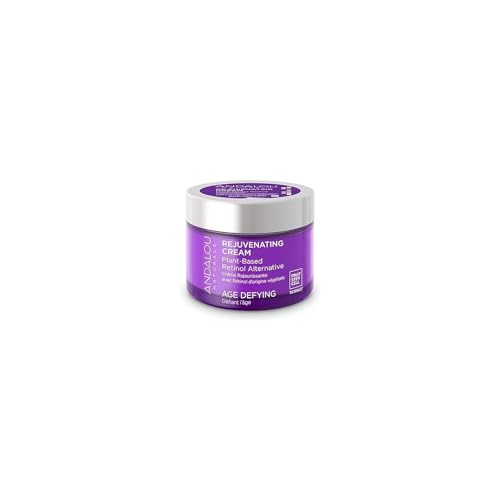
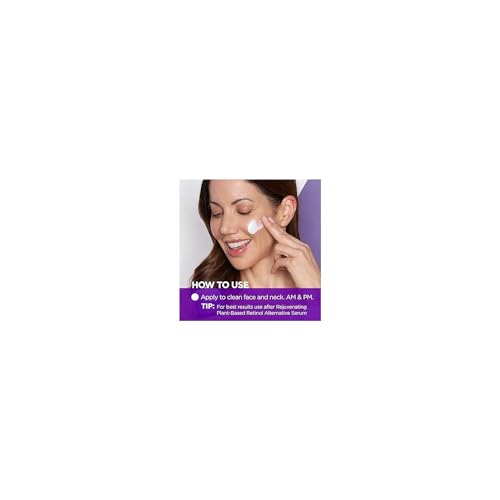

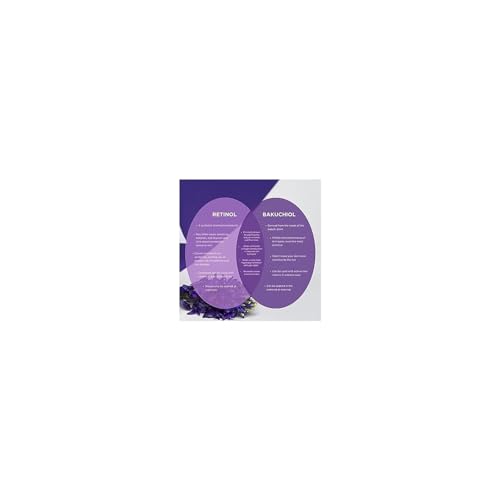
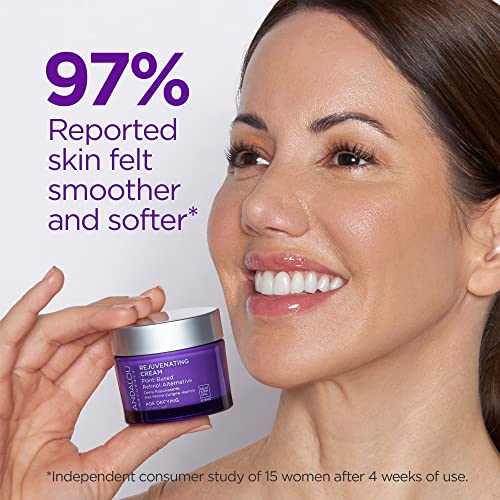
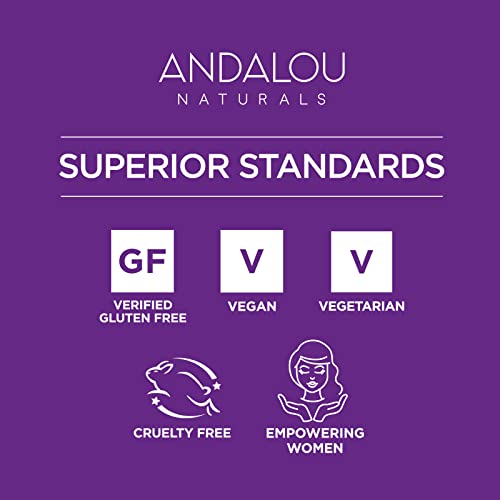
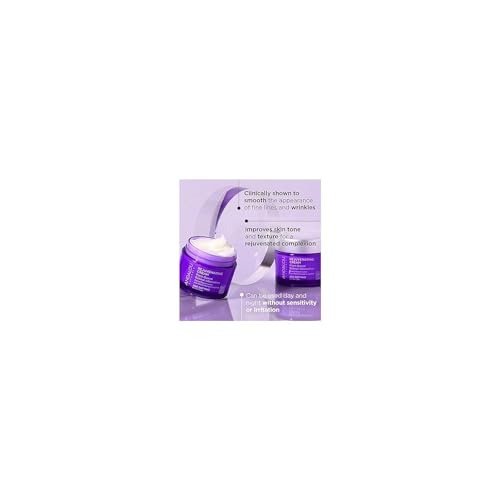
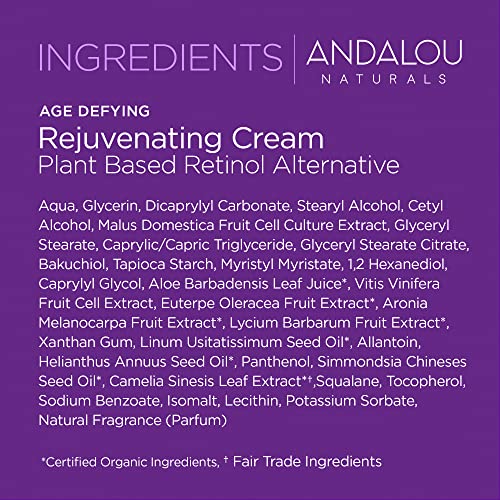
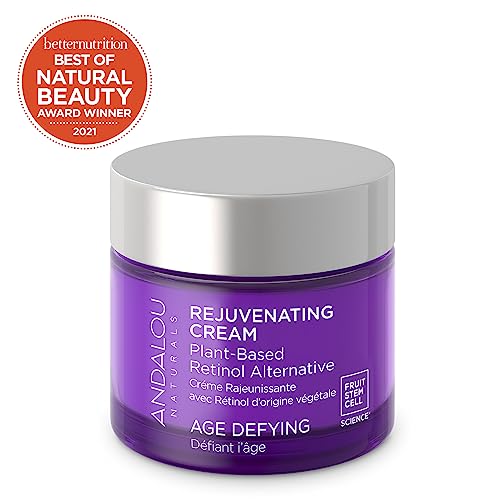
Andalou Naturals Moisturizer - Boosts Vitality, Reduces Lines, Non-GMO Ingredients - 1oz


Fragrance
High RiskFragrance refers to a mixture of aromatic compounds used in products to provide scent. It is commonly listed as 'fragrance' or 'parfum' on product labels and can serve various functions, including enhancing user experience and masking undesirable odors.
Sustai Insights
Fragrance offers functional benefits by improving product appeal; however, it poses significant health risks, notably a high likelihood of causing allergies and allergic contact dermatitis. Environmental risks include potential pollution and endocrine disruption, though its overall carcinogenicity is low. Regulatory bodies have noted concerns regarding its use, leading to a high-risk classification. Safe usage practices should be observed, and alternatives such as natural essential oils are recommended for those sensitive to synthetic fragrances.
Camellia Sinensis (Green Tea) Leaf Extract
Medium RiskCamellia sinensis (green tea) leaf extract is derived from the leaves of the Camellia sinensis plant, primarily known for its antioxidant properties. It is commonly used in cosmetic formulations for its potential to soothe the skin and provide protective benefits against environmental stressors.
Sustai Insights
Camellia sinensis leaf extract offers functional benefits, including antioxidant properties that may protect the skin from damage and enhance product efficacy. While generally regarded as safe, it presents moderate allergenic potential and low concerns for carcinogenic or reproductive toxicity. Environmental risks are minimal; however, the sourcing practices should be evaluated for sustainability. Regulatory bodies do not impose significant restrictions, indicating a low-risk profile overall. Safe usage practices are advisable, and alternatives include other botanical extracts with similar benefits.
Lecithin
Medium RiskLecithin is a naturally occurring lipid found in various plant and animal tissues, primarily composed of phospholipids. It serves as an emulsifier, stabilizing mixtures of oil and water, and is commonly used in food, cosmetics, and pharmaceuticals to improve texture and extend shelf life.
Sustai Insights
Lecithin provides functional benefits as an effective emulsifier and stabilizer, enhancing product texture while being sustainably sourced from natural origins. Health risks are generally low, with moderate concerns regarding allergies and immunotoxicity but minimal cancer or reproductive toxicity risks. Environmental hazards are limited, and it is not classified as a pollutant. Regulatory bodies impose few restrictions. Overall, lecithin presents a medium risk, suggesting caution in usage, especially for sensitive individuals. Alternatives include sunflower lecithin or other plant-based emulsifiers that may offer similar benefits with reduced allergenic potential.
Glycerin
Medium RiskGlycerin (also called glycerol) is a naturally occurring compound commonly used in personal care and cosmetic products. It functions as a humectant, attracting moisture to the skin, and is also utilized as a solvent and emollient to enhance product texture and stability.
Sustai Insights
Glycerin is valued for its effective moisturizing properties and biodegradability, making it a widely accepted ingredient in formulations. It poses low health risks, including low concerns for carcinogenicity and allergies. However, moderate use restrictions exist due to regulatory guidelines. While glycerin does not significantly contribute to environmental pollution, its production process should be ethically sourced. Overall, glycerin holds a medium risk level, emphasizing the importance of safe usage practices and considering sustainable alternatives.
Sodium Benzoate
Medium RiskSodium benzoate is a preservative commonly used in food and cosmetic products to prevent microbial growth and extend shelf life. It is derived from benzoic acid and is effective at low concentrations, often used in acidic environments like beverages and condiments.
Sustai Insights
Sodium benzoate serves effectively as a preservative, contributing to product stability and safety. It is generally recognized as safe with low concerns for carcinogenicity, allergies, and reproductive toxicity, though it faces moderate use restrictions in some regions. Environmental risks include its potential as a pollutant, but it does not bioaccumulate significantly. Regulatory bodies have issued advisories regarding its concentration in products. Overall, the risk level is assessed as medium, with safe usage practices recommended. Alternatives such as potassium sorbate may provide similar benefits with potentially lower restrictions.
Potassium Sorbate
Medium RiskPotassium sorbate is a potassium salt of sorbic acid, primarily used as a preservative in food and cosmetic products. It inhibits the growth of molds, yeast, and some bacteria, extending the shelf life of products. It is commonly found in various formulations due to its effectiveness and low toxicity.
Sustai Insights
Potassium sorbate serves as an effective preservative, preventing microbial growth in food and cosmetic products, which is vital for safety and longevity. Although it has a low risk of carcinogenicity and developmental toxicity, there is a moderate concern regarding allergies and immunotoxicity. Environmentally, it poses minimal risks as it is not significantly bioaccumulative. Regulatory agencies have verified its use, although some products may face restrictions. Overall, it is assessed as a medium risk ingredient, with safe usage practices recommended, and alternatives such as natural preservatives could be considered.
Glyceryl Stearate Citrate
Low RiskGlyceryl stearate citrate is a citric acid ester of glycerol and stearic acid, commonly used as an emulsifier and stabilizer in cosmetic formulations. It helps blend oil and water components, enhancing product texture and consistency.
Sustai Insights
Glyceryl stearate citrate offers functional benefits as an effective emulsifier, improving product stability and texture. It is considered safe, with low concerns for cancer, allergies, and reproductive toxicity. However, it may cause skin irritation in some individuals. Environmental risks are minimal, with no significant bioaccumulation or pollutant potential. Regulatory bodies have not placed significant restrictions on its use. Overall, the ingredient is assessed as low risk, with safe usage practices recommended, and alternatives may include other emulsifiers like cetearyl alcohol.
Aronia Melanocarpa (Black Chokeberry) Fruit Extract
Low RiskAronia melanocarpa, commonly known as black chokeberry, is a fruit extract derived from the Aronia plant. It is primarily used in cosmetic formulations for its antioxidant properties and potential skin benefits. The ingredient is characterized by its deep purple color and rich polyphenolic content.
Sustai Insights
Black chokeberry extract offers functional benefits due to its high antioxidant levels, which may protect the skin from oxidative stress. It is considered sustainably sourced and biodegradable. Health risks are low, with no known carcinogenic, allergenic, or reproductive toxicity concerns. Environmental risks are minimal, as it does not significantly contribute to pollution or bioaccumulation. Regulatory status is favorable, with no current restrictions. Overall, the ingredient is assessed as low risk for consumer safety and environmental impact, making it a suitable choice in formulations.
Tapioca Starch
Low RiskTapioca starch is a carbohydrate extracted from the cassava root, primarily used as a thickening agent in food products and as a binding agent in various formulations. It is known for its ability to provide a smooth texture and enhance the consistency of products.
Sustai Insights
Tapioca starch offers functional benefits such as serving as an effective thickener and stabilizer in food and cosmetic formulations. It is derived from a renewable source and is biodegradable, contributing to sustainability. Health risks are minimal, with low concerns regarding carcinogenicity, allergenic potential, and reproductive toxicity. Environmental risks are also low, with no significant pollutants or bioaccumulation identified. Regulatory bodies, including the FDA, have approved its use without significant restrictions. Overall, tapioca starch presents a low risk profile, making it a safe ingredient in various applications.
Bakuchiol
Low RiskBakuchiol is a naturally derived compound sourced from the seeds and leaves of the Psoralea corylifolia plant. It is primarily used in cosmetic formulations for its purported anti-aging properties, serving as an alternative to retinol in skincare products.
Sustai Insights
Bakuchiol offers functional benefits such as antioxidant properties and potential skin rejuvenation effects, and it is considered sustainably sourced. Health risks are low, with minimal concerns regarding carcinogenicity, allergies, or reproductive toxicity. Environmental risks are also low, and regulatory bodies have not issued significant warnings. Overall, it is assessed as a low-risk ingredient. Usage should follow product guidelines, and alternatives like retinol or other plant-based extracts may be considered.
Vitis Vinifera (Grape) Fruit Extract
Low RiskVitis vinifera (grape) fruit extract is an extract derived from the fruit of grapevine species. It is commonly used in cosmetic formulations for its antioxidant properties and potential skin benefits, such as hydration and soothing effects.
Sustai Insights
Vitis vinifera (grape) fruit extract offers functional benefits as an antioxidant, which may help protect skin from oxidative stress. It is sustainably sourced and generally considered safe, with low concerns for cancer, allergies, or reproductive toxicity. However, it poses minimal environmental risks and is not classified as a pollutant. Regulatory bodies have not imposed significant restrictions on its use. Overall, the ingredient is assessed to have a low risk profile, making it a suitable choice in cosmetic products.
Squalane
Low RiskSqualane is a naturally occurring lipid found in both plants and animals, primarily derived from olives and sugarcane in cosmetic formulations. It functions as a moisturizer and emollient, aiding in skin hydration and maintaining the skin barrier.
Sustai Insights
Squalane offers functional benefits as an effective moisturizing agent, enhancing skin hydration without clogging pores. It is sustainably sourced, often derived from renewable plant materials. Health risks are minimal, with low concerns regarding carcinogenicity, allergies, and endocrine disruption. Environmental impacts are also low, as squalane is biodegradable. Regulatory bodies have not placed significant restrictions on its use, confirming its safety profile. Overall, squalane is assessed as low risk, making it a favorable ingredient in cosmetic products.
Myristyl Myristate
Low RiskMyristyl myristate is an ester derived from myristyl alcohol and myristic acid. It is primarily used in cosmetic formulations as an emollient and thickening agent, contributing to the texture and feel of products such as creams and lotions.
Sustai Insights
Myristyl myristate serves as an effective emollient, enhancing product texture and skin feel. It is considered low risk for health concerns, including carcinogenicity and allergies, with no significant environmental hazards noted; however, there are restrictions on its use in certain products. Overall, the ingredient is assessed to have a low risk profile, making it a suitable choice in cosmetic formulations.
Malus Domestica Fruit Cell Culture
Low RiskMalus domestica fruit cell culture refers to the cellular extracts derived from the apple tree, primarily used in cosmetic formulations for its potential skin benefits. It serves as a source of antioxidants and may contribute to skin conditioning properties in various products.
Sustai Insights
Malus domestica fruit cell culture offers functional benefits such as antioxidant properties, potentially aiding in skin rejuvenation and hydration. It is not associated with significant health risks, including low concerns for carcinogenicity and allergens. Environmental risks are minimal, with no noted bioaccumulation. Regulatory status is clear, as it is not restricted in major regions. Overall, the risk level is low, and safe usage practices are recommended. Alternatives may include other fruit cell cultures for similar benefits.
Dicaprylyl Carbonate
Low RiskDicaprylyl carbonate is a diester of carbonic acid, commonly used in cosmetic formulations as an emollient and skin-conditioning agent. It enhances the texture and feel of products, providing a light, non-greasy finish while helping to dissolve and stabilize other ingredients.
Sustai Insights
Dicaprylyl carbonate offers effective emollient properties, improving product aesthetics and skin feel. It presents a low risk for health concerns like carcinogenicity, allergies, or irritation. Environmentally, it shows low bioaccumulation potential and is not a significant pollutant. Regulatory bodies do not impose notable restrictions on its use. Overall, it is considered low risk, making it a safe choice for cosmetic applications.
Linum Usitatissimum (Linseed) Seed Oil
Low RiskLinum usitatissimum (linseed) seed oil is an oil extracted from the seeds of the flax plant, primarily used for its emollient properties in cosmetic formulations. It is known for its moisturizing and soothing effects on the skin, making it a common ingredient in various personal care products.
Sustai Insights
Linum usitatissimum (linseed) seed oil is recognized for its emollient benefits, providing hydration and skin barrier support. It is sustainably sourced and biodegradable. Health risks are minimal, with low concerns for carcinogenicity, allergies, or reproductive toxicity. Environmental risks are also low, with no significant pollutant or bioaccumulative potential. Regulatory bodies have not issued restrictions. Overall, it presents a low risk, making it a safe choice in formulations. For alternatives, consider other plant-based oils like jojoba or argan oil.
Euterpe Oleracea (Acai) Fruit Extract
Low RiskEuterpe oleracea (acai) fruit extract is derived from the acai palm's fruit, primarily used in cosmetic formulations for its antioxidant properties and skin conditioning benefits. It is noted for its rich content of polyphenols and vitamins, contributing to overall product efficacy.
Sustai Insights
Euterpe oleracea extract provides functional benefits, including antioxidant properties that can enhance skin health and support hydration. It is sustainably sourced, contributing to environmentally friendly practices. Health risks are minimal, with low concerns for carcinogenicity, allergies, and reproductive toxicity. Environmental risks are also low, with no significant pollutants or bioaccumulation noted. Regulatory status is favorable, with no major restrictions. Overall, the ingredient is assessed as low risk, with safe usage practices advised for sensitive populations.
Lycium Barbarum (Matrimony Vine) Fruit Extract
Low RiskLycium barbarum (matrimony vine) fruit extract is derived from the fruit of the Lycium barbarum plant, traditionally used in herbal medicine. It is commonly incorporated in cosmetic and personal care products for its potential antioxidant properties and as a natural ingredient aimed at enhancing skin appearance and health.
Sustai Insights
Lycium barbarum fruit extract offers functional benefits such as antioxidant activity and possible skin conditioning effects. It is considered sustainably sourced, with low health risks, including negligible concerns for carcinogenicity, allergies, and reproductive toxicity. Environmental impact is minimal, with no significant pollutant or bioaccumulation concerns. Regulatory assessments indicate no current restrictions. Overall, the risk level is low, and safe usage practices should be followed. Alternatives may include other botanical extracts with similar properties.
Allantoin
Low RiskAllantoin is a naturally occurring nitrogenous compound found in various plants and animals. It is commonly used in cosmetic formulations for its soothing and moisturizing properties, as well as its ability to promote skin cell turnover and healing.
Sustai Insights
Allantoin offers functional benefits such as skin soothing, hydration, and promoting cell regeneration. It is generally recognized as safe, with low concerns regarding carcinogenicity, allergies, and reproductive toxicity. Environmentally, it poses minimal risks, being biodegradable and sustainably sourced. Regulatory bodies do not impose significant restrictions on its use. Overall, the risk level associated with allantoin is low, making it a favorable ingredient in personal care products.
Stearyl Alcohol
Low RiskStearyl alcohol is a compound produced from the hydrogenation of stearic acid, commonly used in cosmetic formulations as an emulsifier and thickening agent. It helps stabilize products by blending oil and water phases, enhancing texture and consistency.
Sustai Insights
Stearyl alcohol provides functional benefits as an emulsifier and stabilizer, contributing to improved product texture. It is generally regarded as safe with low concerns for cancer, allergies, and reproductive toxicity. However, it may cause moderate skin, eye, or respiratory irritation. Regulatory bodies do not impose significant restrictions, indicating a low overall risk. While it poses minimal health and environmental hazards, caution is advised for sensitive individuals. Alternatives like cetyl alcohol or plant-based emulsifiers may offer safer options for formulators.
1,2 Hexanediol
Low Risk1,2 Hexanediol is a diol compound commonly used in cosmetic formulations primarily as a solvent, humectant, and preservative. It helps to stabilize products and maintain moisture levels, enhancing the texture and longevity of formulations.
Sustai Insights
1,2 Hexanediol offers functional benefits as a preservative and humectant, contributing to product stability and moisture retention. It is considered low-risk for health concerns, including carcinogenicity, allergies, and reproductive toxicity. Environmental impacts are minimal, with no significant pollutant or bioaccumulation potential. Regulatory reviews indicate compliance with safety standards, though it is subject to usage restrictions in certain formulations. Overall, the ingredient is assessed as low risk, with safe usage recommended in appropriate concentrations.
Isomalt
Low RiskIsomalt is a mixture of polysaccharides produced from sucrose, primarily used as a sugar substitute in various food and cosmetic products due to its functional properties such as sweetness and stability. It is often valued for its lower caloric content compared to traditional sugars.
Sustai Insights
Isomalt serves effectively as a sweetener and bulking agent, contributing to product texture and flavor without the high caloric content of sugar. It is considered low-risk concerning health effects, with minimal concerns regarding carcinogenicity, allergies, or reproductive toxicity. Environmentally, isomalt is not classified as a significant pollutant and poses low bioaccumulation risk. While regulatory bodies do not impose strict limitations, it is noted that certain formulations should avoid excess isomalt. Overall, isomalt presents a low-risk profile, making it a suitable choice in formulations.
Water
Low RiskWater is a clear, colorless liquid essential for various biological processes. It serves as a solvent in formulations, facilitating the dissolution of other ingredients and enhancing product texture and application. Additionally, water plays a crucial role in hydration and is a key component in many cosmetic and personal care products.
Sustai Insights
Water is an effective solvent and hydrator, contributing to the texture and efficacy of formulations. It is biodegradable and generally regarded as safe, with low concerns regarding carcinogenicity, allergies, and reproductive toxicity. However, excessive water usage can lead to environmental concerns, particularly regarding resource depletion. Regulatory bodies do not impose restrictions on water use in cosmetics. Overall, the risks associated with water are low, making it a safe and essential ingredient.
Panthenol
Low RiskPanthenol, a derivative of vitamin B5, is commonly used in cosmetic formulations for its moisturizing and skin-conditioning properties. It acts as a humectant, helping to retain moisture in the skin and hair, thereby improving hydration and texture.
Sustai Insights
Panthenol offers functional benefits such as effective hydration and skin conditioning, making it valuable in various cosmetic products. It is considered low risk regarding health impacts, with minimal concerns about carcinogenicity, allergies, or reproductive toxicity. Environmental risks are also low, with no significant pollutant or bioaccumulation potential. Regulatory bodies have not imposed restrictions on its use. Safe usage practices include adhering to recommended concentrations. Alternatives like glycerin may provide similar moisturizing benefits, but overall, panthenol is assessed as a low-risk ingredient.
Tocopherol
Low RiskTocopherols are a class of naturally occurring compounds, primarily known for their role as antioxidants. They are commonly used in cosmetic and skincare products to help stabilize formulations and protect ingredients from oxidative damage.
Sustai Insights
Tocopherols provide functional benefits such as antioxidant protection and skin conditioning. They are generally recognized as safe, with low concerns regarding carcinogenicity, allergies, and reproductive toxicity. However, enhanced skin absorption and potential endocrine disruption are noted. Regulatory bodies have not imposed significant restrictions on tocopherols, categorizing the overall risk as low. Safe usage practices should be observed, and while alternatives exist, tocopherols remain a viable option in formulations.
Xanthan Gum
Low RiskXanthan gum is a polysaccharide, a sugar-based compound produced by the fermentation of glucose or sucrose. It is commonly used as a thickening agent and stabilizer in various food and cosmetic products due to its ability to improve texture and prevent ingredient separation.
Sustai Insights
Xanthan gum serves effectively as a thickener and stabilizer, enhancing product texture and consistency. It is biodegradable and typically derived from renewable sources, supporting sustainability efforts. Health risks are minimal, with low concerns regarding carcinogenicity, allergies, and reproductive toxicity. Environmental impact is similarly low, posing no significant hazards. Regulatory agencies, including the FDA, regard it as safe for use, with no significant restrictions. Overall, xanthan gum is assessed as low risk, making it a suitable ingredient in formulations.
Cetyl Alcohol
Low RiskCetyl alcohol is a long-chain organic alcohol commonly used in cosmetic formulations. It serves as an emollient, emulsifier, and thickening agent, enhancing the texture and stability of products. Cetyl alcohol is derived from natural sources, such as coconut or palm oil, and is often included in creams, lotions, and hair conditioners.
Sustai Insights
Cetyl alcohol offers functional benefits as an emollient and emulsifier, improving product texture and stability. It is biodegradable and sourced from renewable materials, contributing to sustainability. Health risks are minimal, with low concerns for carcinogenicity, allergies, or reproductive toxicity. Environmental impact is also low, with no significant pollutant or bioaccumulation potential. Regulatory bodies have not placed restrictions on its use, indicating a favorable safety profile. Overall, cetyl alcohol is assessed as low risk, and safe usage practices include ensuring proper formulation concentrations.
Caprylyl Glycol
Low RiskCaprylyl glycol (1,2-octanediol) is a multifunctional cosmetic ingredient primarily used as a skin-conditioning agent and preservative. It is derived from caprylic acid, a fatty acid found in coconut oil, and is commonly included in personal care products for its moisturizing properties.
Sustai Insights
Caprylyl glycol offers functional benefits such as acting as an effective humectant and preservative, enhancing skin hydration and product stability. It is considered to have low health risks, with no significant concerns regarding carcinogenicity, allergies, or reproductive toxicity. Environmentally, it poses minimal risks, being non-bioaccumulative and not linked to pollution. Regulatory assessments affirm its safety, with no major advisories against its use. Overall, the ingredient is assessed to have a low risk, making it a suitable choice in cosmetic formulations.
Glyceryl Monostearate
Low RiskGlyceryl monostearate is a monoester of glycerol and stearic acid, commonly used as an emulsifier and stabilizer in food and cosmetic products. It helps blend oil and water-based ingredients, improving product texture and consistency.
Sustai Insights
Glyceryl monostearate offers functional benefits as an effective emulsifier, enhancing product stability and texture. It is derived from natural sources and is considered biodegradable. Health risks associated with it are low, as it shows no significant carcinogenic, allergenic, or reproductive toxicity effects. Environmental concerns are minimal, with no known pollutant or bioaccumulation issues. Regulatory bodies have not restricted its use, and it is generally regarded as safe. Overall, glyceryl monostearate presents a low risk profile, making it a suitable ingredient in various applications.
Caprylic/Capric Triglyceride
Low RiskCaprylic/capric triglyceride is a mixed triester derived from coconut oil and glycerin, primarily used as an emollient and skin-conditioning agent in cosmetic formulations. It serves to improve the texture and spreadability of products while providing a lightweight, non-greasy feel on the skin.
Sustai Insights
Caprylic/capric triglyceride offers functional benefits as an effective emollient, enhancing skin hydration without clogging pores. It is biodegradable, contributing to sustainability. Health risks are low, with minimal concerns regarding carcinogenicity, allergies, or reproductive toxicity. Environmental impacts are also low, with no known pollutant status. Regulatory assessments indicate no current restrictions. Overall, this ingredient presents a low risk profile, making it a safe choice in cosmetic applications.
Helianthus Annuus (Sunflower) Seed Oil
Low RiskHelianthus annuus (sunflower) seed oil is derived from the seeds of the sunflower plant. It serves primarily as an emollient and moisturizer in cosmetic formulations, helping to maintain skin hydration and improve texture.
Sustai Insights
Sunflower seed oil is effective as an emollient, providing moisture and improving skin texture while being biodegradable and sustainably sourced. It poses low health risks, including negligible concerns for carcinogenicity, allergies, or reproductive toxicity. Environmentally, it does not significantly contribute to pollution or bioaccumulation. Regulatory bodies currently do not list any advisories for this ingredient. Overall, it is assessed as low risk, with safe usage practices recommended. Alternatives include oils like jojoba or almond oil for those seeking different properties.
Simmondsia Chinensis (Jojoba) Seed Oil
Low RiskSimmondsia chinensis (jojoba) seed oil is extracted from the seeds of the jojoba plant. It is commonly used in cosmetics for its moisturizing properties and ability to mimic human sebum, making it beneficial for skin and hair care formulations.
Sustai Insights
Jojoba seed oil offers functional benefits such as effective moisturization and emollience, contributing to skin hydration and smoothness. It is sustainably sourced and biodegradable. Health risks are low, with minimal concerns regarding carcinogenicity, allergies, and reproductive toxicity. Environmental risks are also low, as it does not significantly contribute to pollution or bioaccumulation. Currently, there are no regulatory restrictions on its use. Overall, the risk level is low, and it is considered a safe ingredient with no significant adverse effects.
Aloe Barbadensis (Aloe Vera) Leaf Juice
Low RiskAloe barbadensis (aloe vera) leaf juice is derived from the succulent aloe vera plant, known for its hydrating and soothing properties. It is commonly used in cosmetic formulations for its moisturizing effects and is often included in products aimed at skin care and healing.
Sustai Insights
Aloe vera leaf juice offers functional benefits as a moisturizer and skin soothing agent, while being sustainably sourced and biodegradable. Health risks are low, with minimal concerns regarding carcinogenicity, allergies, and reproductive toxicity. Environmental impact is also low, with no significant pollutants identified. Regulatory agencies impose few restrictions. Overall, the ingredient poses a low risk, making it a favorable choice in cosmetic formulations.
Glyceryl Stearate Citrate
Low RiskGlyceryl stearate citrate is a citric acid ester of glycerol and stearic acid, commonly used as an emulsifier and stabilizer in cosmetic formulations. It helps blend oil and water components, enhancing product texture and consistency.
Sustai Insights
Glyceryl stearate citrate offers functional benefits as an effective emulsifier, improving product stability and texture. It is considered safe, with low concerns for cancer, allergies, and reproductive toxicity. However, it may cause skin irritation in some individuals. Environmental risks are minimal, with no significant bioaccumulation or pollutant potential. Regulatory bodies have not placed significant restrictions on its use. Overall, the ingredient is assessed as low risk, with safe usage practices recommended, and alternatives may include other emulsifiers like cetearyl alcohol.
Aronia Melanocarpa (Black Chokeberry) Fruit Extract
Low RiskAronia melanocarpa, commonly known as black chokeberry, is a fruit extract derived from the Aronia plant. It is primarily used in cosmetic formulations for its antioxidant properties and potential skin benefits. The ingredient is characterized by its deep purple color and rich polyphenolic content.
Sustai Insights
Black chokeberry extract offers functional benefits due to its high antioxidant levels, which may protect the skin from oxidative stress. It is considered sustainably sourced and biodegradable. Health risks are low, with no known carcinogenic, allergenic, or reproductive toxicity concerns. Environmental risks are minimal, as it does not significantly contribute to pollution or bioaccumulation. Regulatory status is favorable, with no current restrictions. Overall, the ingredient is assessed as low risk for consumer safety and environmental impact, making it a suitable choice in formulations.
Tapioca Starch
Low RiskTapioca starch is a carbohydrate extracted from the cassava root, primarily used as a thickening agent in food products and as a binding agent in various formulations. It is known for its ability to provide a smooth texture and enhance the consistency of products.
Sustai Insights
Tapioca starch offers functional benefits such as serving as an effective thickener and stabilizer in food and cosmetic formulations. It is derived from a renewable source and is biodegradable, contributing to sustainability. Health risks are minimal, with low concerns regarding carcinogenicity, allergenic potential, and reproductive toxicity. Environmental risks are also low, with no significant pollutants or bioaccumulation identified. Regulatory bodies, including the FDA, have approved its use without significant restrictions. Overall, tapioca starch presents a low risk profile, making it a safe ingredient in various applications.
Camellia Sinensis (Green Tea) Leaf Extract
Medium RiskCamellia sinensis (green tea) leaf extract is derived from the leaves of the Camellia sinensis plant, primarily known for its antioxidant properties. It is commonly used in cosmetic formulations for its potential to soothe the skin and provide protective benefits against environmental stressors.
Sustai Insights
Camellia sinensis leaf extract offers functional benefits, including antioxidant properties that may protect the skin from damage and enhance product efficacy. While generally regarded as safe, it presents moderate allergenic potential and low concerns for carcinogenic or reproductive toxicity. Environmental risks are minimal; however, the sourcing practices should be evaluated for sustainability. Regulatory bodies do not impose significant restrictions, indicating a low-risk profile overall. Safe usage practices are advisable, and alternatives include other botanical extracts with similar benefits.
Bakuchiol
Low RiskBakuchiol is a naturally derived compound sourced from the seeds and leaves of the Psoralea corylifolia plant. It is primarily used in cosmetic formulations for its purported anti-aging properties, serving as an alternative to retinol in skincare products.
Sustai Insights
Bakuchiol offers functional benefits such as antioxidant properties and potential skin rejuvenation effects, and it is considered sustainably sourced. Health risks are low, with minimal concerns regarding carcinogenicity, allergies, or reproductive toxicity. Environmental risks are also low, and regulatory bodies have not issued significant warnings. Overall, it is assessed as a low-risk ingredient. Usage should follow product guidelines, and alternatives like retinol or other plant-based extracts may be considered.
Vitis Vinifera (Grape) Fruit Extract
Low RiskVitis vinifera (grape) fruit extract is an extract derived from the fruit of grapevine species. It is commonly used in cosmetic formulations for its antioxidant properties and potential skin benefits, such as hydration and soothing effects.
Sustai Insights
Vitis vinifera (grape) fruit extract offers functional benefits as an antioxidant, which may help protect skin from oxidative stress. It is sustainably sourced and generally considered safe, with low concerns for cancer, allergies, or reproductive toxicity. However, it poses minimal environmental risks and is not classified as a pollutant. Regulatory bodies have not imposed significant restrictions on its use. Overall, the ingredient is assessed to have a low risk profile, making it a suitable choice in cosmetic products.
Lecithin
Medium RiskLecithin is a naturally occurring lipid found in various plant and animal tissues, primarily composed of phospholipids. It serves as an emulsifier, stabilizing mixtures of oil and water, and is commonly used in food, cosmetics, and pharmaceuticals to improve texture and extend shelf life.
Sustai Insights
Lecithin provides functional benefits as an effective emulsifier and stabilizer, enhancing product texture while being sustainably sourced from natural origins. Health risks are generally low, with moderate concerns regarding allergies and immunotoxicity but minimal cancer or reproductive toxicity risks. Environmental hazards are limited, and it is not classified as a pollutant. Regulatory bodies impose few restrictions. Overall, lecithin presents a medium risk, suggesting caution in usage, especially for sensitive individuals. Alternatives include sunflower lecithin or other plant-based emulsifiers that may offer similar benefits with reduced allergenic potential.
Squalane
Low RiskSqualane is a naturally occurring lipid found in both plants and animals, primarily derived from olives and sugarcane in cosmetic formulations. It functions as a moisturizer and emollient, aiding in skin hydration and maintaining the skin barrier.
Sustai Insights
Squalane offers functional benefits as an effective moisturizing agent, enhancing skin hydration without clogging pores. It is sustainably sourced, often derived from renewable plant materials. Health risks are minimal, with low concerns regarding carcinogenicity, allergies, and endocrine disruption. Environmental impacts are also low, as squalane is biodegradable. Regulatory bodies have not placed significant restrictions on its use, confirming its safety profile. Overall, squalane is assessed as low risk, making it a favorable ingredient in cosmetic products.
Myristyl Myristate
Low RiskMyristyl myristate is an ester derived from myristyl alcohol and myristic acid. It is primarily used in cosmetic formulations as an emollient and thickening agent, contributing to the texture and feel of products such as creams and lotions.
Sustai Insights
Myristyl myristate serves as an effective emollient, enhancing product texture and skin feel. It is considered low risk for health concerns, including carcinogenicity and allergies, with no significant environmental hazards noted; however, there are restrictions on its use in certain products. Overall, the ingredient is assessed to have a low risk profile, making it a suitable choice in cosmetic formulations.
Malus Domestica Fruit Cell Culture
Low RiskMalus domestica fruit cell culture refers to the cellular extracts derived from the apple tree, primarily used in cosmetic formulations for its potential skin benefits. It serves as a source of antioxidants and may contribute to skin conditioning properties in various products.
Sustai Insights
Malus domestica fruit cell culture offers functional benefits such as antioxidant properties, potentially aiding in skin rejuvenation and hydration. It is not associated with significant health risks, including low concerns for carcinogenicity and allergens. Environmental risks are minimal, with no noted bioaccumulation. Regulatory status is clear, as it is not restricted in major regions. Overall, the risk level is low, and safe usage practices are recommended. Alternatives may include other fruit cell cultures for similar benefits.
Dicaprylyl Carbonate
Low RiskDicaprylyl carbonate is a diester of carbonic acid, commonly used in cosmetic formulations as an emollient and skin-conditioning agent. It enhances the texture and feel of products, providing a light, non-greasy finish while helping to dissolve and stabilize other ingredients.
Sustai Insights
Dicaprylyl carbonate offers effective emollient properties, improving product aesthetics and skin feel. It presents a low risk for health concerns like carcinogenicity, allergies, or irritation. Environmentally, it shows low bioaccumulation potential and is not a significant pollutant. Regulatory bodies do not impose notable restrictions on its use. Overall, it is considered low risk, making it a safe choice for cosmetic applications.
Linum Usitatissimum (Linseed) Seed Oil
Low RiskLinum usitatissimum (linseed) seed oil is an oil extracted from the seeds of the flax plant, primarily used for its emollient properties in cosmetic formulations. It is known for its moisturizing and soothing effects on the skin, making it a common ingredient in various personal care products.
Sustai Insights
Linum usitatissimum (linseed) seed oil is recognized for its emollient benefits, providing hydration and skin barrier support. It is sustainably sourced and biodegradable. Health risks are minimal, with low concerns for carcinogenicity, allergies, or reproductive toxicity. Environmental risks are also low, with no significant pollutant or bioaccumulative potential. Regulatory bodies have not issued restrictions. Overall, it presents a low risk, making it a safe choice in formulations. For alternatives, consider other plant-based oils like jojoba or argan oil.
Euterpe Oleracea (Acai) Fruit Extract
Low RiskEuterpe oleracea (acai) fruit extract is derived from the acai palm's fruit, primarily used in cosmetic formulations for its antioxidant properties and skin conditioning benefits. It is noted for its rich content of polyphenols and vitamins, contributing to overall product efficacy.
Sustai Insights
Euterpe oleracea extract provides functional benefits, including antioxidant properties that can enhance skin health and support hydration. It is sustainably sourced, contributing to environmentally friendly practices. Health risks are minimal, with low concerns for carcinogenicity, allergies, and reproductive toxicity. Environmental risks are also low, with no significant pollutants or bioaccumulation noted. Regulatory status is favorable, with no major restrictions. Overall, the ingredient is assessed as low risk, with safe usage practices advised for sensitive populations.
Lycium Barbarum (Matrimony Vine) Fruit Extract
Low RiskLycium barbarum (matrimony vine) fruit extract is derived from the fruit of the Lycium barbarum plant, traditionally used in herbal medicine. It is commonly incorporated in cosmetic and personal care products for its potential antioxidant properties and as a natural ingredient aimed at enhancing skin appearance and health.
Sustai Insights
Lycium barbarum fruit extract offers functional benefits such as antioxidant activity and possible skin conditioning effects. It is considered sustainably sourced, with low health risks, including negligible concerns for carcinogenicity, allergies, and reproductive toxicity. Environmental impact is minimal, with no significant pollutant or bioaccumulation concerns. Regulatory assessments indicate no current restrictions. Overall, the risk level is low, and safe usage practices should be followed. Alternatives may include other botanical extracts with similar properties.
Allantoin
Low RiskAllantoin is a naturally occurring nitrogenous compound found in various plants and animals. It is commonly used in cosmetic formulations for its soothing and moisturizing properties, as well as its ability to promote skin cell turnover and healing.
Sustai Insights
Allantoin offers functional benefits such as skin soothing, hydration, and promoting cell regeneration. It is generally recognized as safe, with low concerns regarding carcinogenicity, allergies, and reproductive toxicity. Environmentally, it poses minimal risks, being biodegradable and sustainably sourced. Regulatory bodies do not impose significant restrictions on its use. Overall, the risk level associated with allantoin is low, making it a favorable ingredient in personal care products.
Stearyl Alcohol
Low RiskStearyl alcohol is a compound produced from the hydrogenation of stearic acid, commonly used in cosmetic formulations as an emulsifier and thickening agent. It helps stabilize products by blending oil and water phases, enhancing texture and consistency.
Sustai Insights
Stearyl alcohol provides functional benefits as an emulsifier and stabilizer, contributing to improved product texture. It is generally regarded as safe with low concerns for cancer, allergies, and reproductive toxicity. However, it may cause moderate skin, eye, or respiratory irritation. Regulatory bodies do not impose significant restrictions, indicating a low overall risk. While it poses minimal health and environmental hazards, caution is advised for sensitive individuals. Alternatives like cetyl alcohol or plant-based emulsifiers may offer safer options for formulators.
1,2 Hexanediol
Low Risk1,2 Hexanediol is a diol compound commonly used in cosmetic formulations primarily as a solvent, humectant, and preservative. It helps to stabilize products and maintain moisture levels, enhancing the texture and longevity of formulations.
Sustai Insights
1,2 Hexanediol offers functional benefits as a preservative and humectant, contributing to product stability and moisture retention. It is considered low-risk for health concerns, including carcinogenicity, allergies, and reproductive toxicity. Environmental impacts are minimal, with no significant pollutant or bioaccumulation potential. Regulatory reviews indicate compliance with safety standards, though it is subject to usage restrictions in certain formulations. Overall, the ingredient is assessed as low risk, with safe usage recommended in appropriate concentrations.
Isomalt
Low RiskIsomalt is a mixture of polysaccharides produced from sucrose, primarily used as a sugar substitute in various food and cosmetic products due to its functional properties such as sweetness and stability. It is often valued for its lower caloric content compared to traditional sugars.
Sustai Insights
Isomalt serves effectively as a sweetener and bulking agent, contributing to product texture and flavor without the high caloric content of sugar. It is considered low-risk concerning health effects, with minimal concerns regarding carcinogenicity, allergies, or reproductive toxicity. Environmentally, isomalt is not classified as a significant pollutant and poses low bioaccumulation risk. While regulatory bodies do not impose strict limitations, it is noted that certain formulations should avoid excess isomalt. Overall, isomalt presents a low-risk profile, making it a suitable choice in formulations.
Water
Low RiskWater is a clear, colorless liquid essential for various biological processes. It serves as a solvent in formulations, facilitating the dissolution of other ingredients and enhancing product texture and application. Additionally, water plays a crucial role in hydration and is a key component in many cosmetic and personal care products.
Sustai Insights
Water is an effective solvent and hydrator, contributing to the texture and efficacy of formulations. It is biodegradable and generally regarded as safe, with low concerns regarding carcinogenicity, allergies, and reproductive toxicity. However, excessive water usage can lead to environmental concerns, particularly regarding resource depletion. Regulatory bodies do not impose restrictions on water use in cosmetics. Overall, the risks associated with water are low, making it a safe and essential ingredient.
Glycerin
Medium RiskGlycerin (also called glycerol) is a naturally occurring compound commonly used in personal care and cosmetic products. It functions as a humectant, attracting moisture to the skin, and is also utilized as a solvent and emollient to enhance product texture and stability.
Sustai Insights
Glycerin is valued for its effective moisturizing properties and biodegradability, making it a widely accepted ingredient in formulations. It poses low health risks, including low concerns for carcinogenicity and allergies. However, moderate use restrictions exist due to regulatory guidelines. While glycerin does not significantly contribute to environmental pollution, its production process should be ethically sourced. Overall, glycerin holds a medium risk level, emphasizing the importance of safe usage practices and considering sustainable alternatives.
Fragrance
High RiskFragrance refers to a mixture of aromatic compounds used in products to provide scent. It is commonly listed as 'fragrance' or 'parfum' on product labels and can serve various functions, including enhancing user experience and masking undesirable odors.
Sustai Insights
Fragrance offers functional benefits by improving product appeal; however, it poses significant health risks, notably a high likelihood of causing allergies and allergic contact dermatitis. Environmental risks include potential pollution and endocrine disruption, though its overall carcinogenicity is low. Regulatory bodies have noted concerns regarding its use, leading to a high-risk classification. Safe usage practices should be observed, and alternatives such as natural essential oils are recommended for those sensitive to synthetic fragrances.
Panthenol
Low RiskPanthenol, a derivative of vitamin B5, is commonly used in cosmetic formulations for its moisturizing and skin-conditioning properties. It acts as a humectant, helping to retain moisture in the skin and hair, thereby improving hydration and texture.
Sustai Insights
Panthenol offers functional benefits such as effective hydration and skin conditioning, making it valuable in various cosmetic products. It is considered low risk regarding health impacts, with minimal concerns about carcinogenicity, allergies, or reproductive toxicity. Environmental risks are also low, with no significant pollutant or bioaccumulation potential. Regulatory bodies have not imposed restrictions on its use. Safe usage practices include adhering to recommended concentrations. Alternatives like glycerin may provide similar moisturizing benefits, but overall, panthenol is assessed as a low-risk ingredient.
Tocopherol
Low RiskTocopherols are a class of naturally occurring compounds, primarily known for their role as antioxidants. They are commonly used in cosmetic and skincare products to help stabilize formulations and protect ingredients from oxidative damage.
Sustai Insights
Tocopherols provide functional benefits such as antioxidant protection and skin conditioning. They are generally recognized as safe, with low concerns regarding carcinogenicity, allergies, and reproductive toxicity. However, enhanced skin absorption and potential endocrine disruption are noted. Regulatory bodies have not imposed significant restrictions on tocopherols, categorizing the overall risk as low. Safe usage practices should be observed, and while alternatives exist, tocopherols remain a viable option in formulations.
Xanthan Gum
Low RiskXanthan gum is a polysaccharide, a sugar-based compound produced by the fermentation of glucose or sucrose. It is commonly used as a thickening agent and stabilizer in various food and cosmetic products due to its ability to improve texture and prevent ingredient separation.
Sustai Insights
Xanthan gum serves effectively as a thickener and stabilizer, enhancing product texture and consistency. It is biodegradable and typically derived from renewable sources, supporting sustainability efforts. Health risks are minimal, with low concerns regarding carcinogenicity, allergies, and reproductive toxicity. Environmental impact is similarly low, posing no significant hazards. Regulatory agencies, including the FDA, regard it as safe for use, with no significant restrictions. Overall, xanthan gum is assessed as low risk, making it a suitable ingredient in formulations.
Cetyl Alcohol
Low RiskCetyl alcohol is a long-chain organic alcohol commonly used in cosmetic formulations. It serves as an emollient, emulsifier, and thickening agent, enhancing the texture and stability of products. Cetyl alcohol is derived from natural sources, such as coconut or palm oil, and is often included in creams, lotions, and hair conditioners.
Sustai Insights
Cetyl alcohol offers functional benefits as an emollient and emulsifier, improving product texture and stability. It is biodegradable and sourced from renewable materials, contributing to sustainability. Health risks are minimal, with low concerns for carcinogenicity, allergies, or reproductive toxicity. Environmental impact is also low, with no significant pollutant or bioaccumulation potential. Regulatory bodies have not placed restrictions on its use, indicating a favorable safety profile. Overall, cetyl alcohol is assessed as low risk, and safe usage practices include ensuring proper formulation concentrations.
Caprylyl Glycol
Low RiskCaprylyl glycol (1,2-octanediol) is a multifunctional cosmetic ingredient primarily used as a skin-conditioning agent and preservative. It is derived from caprylic acid, a fatty acid found in coconut oil, and is commonly included in personal care products for its moisturizing properties.
Sustai Insights
Caprylyl glycol offers functional benefits such as acting as an effective humectant and preservative, enhancing skin hydration and product stability. It is considered to have low health risks, with no significant concerns regarding carcinogenicity, allergies, or reproductive toxicity. Environmentally, it poses minimal risks, being non-bioaccumulative and not linked to pollution. Regulatory assessments affirm its safety, with no major advisories against its use. Overall, the ingredient is assessed to have a low risk, making it a suitable choice in cosmetic formulations.
Sodium Benzoate
Medium RiskSodium benzoate is a preservative commonly used in food and cosmetic products to prevent microbial growth and extend shelf life. It is derived from benzoic acid and is effective at low concentrations, often used in acidic environments like beverages and condiments.
Sustai Insights
Sodium benzoate serves effectively as a preservative, contributing to product stability and safety. It is generally recognized as safe with low concerns for carcinogenicity, allergies, and reproductive toxicity, though it faces moderate use restrictions in some regions. Environmental risks include its potential as a pollutant, but it does not bioaccumulate significantly. Regulatory bodies have issued advisories regarding its concentration in products. Overall, the risk level is assessed as medium, with safe usage practices recommended. Alternatives such as potassium sorbate may provide similar benefits with potentially lower restrictions.
Potassium Sorbate
Medium RiskPotassium sorbate is a potassium salt of sorbic acid, primarily used as a preservative in food and cosmetic products. It inhibits the growth of molds, yeast, and some bacteria, extending the shelf life of products. It is commonly found in various formulations due to its effectiveness and low toxicity.
Sustai Insights
Potassium sorbate serves as an effective preservative, preventing microbial growth in food and cosmetic products, which is vital for safety and longevity. Although it has a low risk of carcinogenicity and developmental toxicity, there is a moderate concern regarding allergies and immunotoxicity. Environmentally, it poses minimal risks as it is not significantly bioaccumulative. Regulatory agencies have verified its use, although some products may face restrictions. Overall, it is assessed as a medium risk ingredient, with safe usage practices recommended, and alternatives such as natural preservatives could be considered.
Glyceryl Monostearate
Low RiskGlyceryl monostearate is a monoester of glycerol and stearic acid, commonly used as an emulsifier and stabilizer in food and cosmetic products. It helps blend oil and water-based ingredients, improving product texture and consistency.
Sustai Insights
Glyceryl monostearate offers functional benefits as an effective emulsifier, enhancing product stability and texture. It is derived from natural sources and is considered biodegradable. Health risks associated with it are low, as it shows no significant carcinogenic, allergenic, or reproductive toxicity effects. Environmental concerns are minimal, with no known pollutant or bioaccumulation issues. Regulatory bodies have not restricted its use, and it is generally regarded as safe. Overall, glyceryl monostearate presents a low risk profile, making it a suitable ingredient in various applications.
Caprylic/Capric Triglyceride
Low RiskCaprylic/capric triglyceride is a mixed triester derived from coconut oil and glycerin, primarily used as an emollient and skin-conditioning agent in cosmetic formulations. It serves to improve the texture and spreadability of products while providing a lightweight, non-greasy feel on the skin.
Sustai Insights
Caprylic/capric triglyceride offers functional benefits as an effective emollient, enhancing skin hydration without clogging pores. It is biodegradable, contributing to sustainability. Health risks are low, with minimal concerns regarding carcinogenicity, allergies, or reproductive toxicity. Environmental impacts are also low, with no known pollutant status. Regulatory assessments indicate no current restrictions. Overall, this ingredient presents a low risk profile, making it a safe choice in cosmetic applications.
Helianthus Annuus (Sunflower) Seed Oil
Low RiskHelianthus annuus (sunflower) seed oil is derived from the seeds of the sunflower plant. It serves primarily as an emollient and moisturizer in cosmetic formulations, helping to maintain skin hydration and improve texture.
Sustai Insights
Sunflower seed oil is effective as an emollient, providing moisture and improving skin texture while being biodegradable and sustainably sourced. It poses low health risks, including negligible concerns for carcinogenicity, allergies, or reproductive toxicity. Environmentally, it does not significantly contribute to pollution or bioaccumulation. Regulatory bodies currently do not list any advisories for this ingredient. Overall, it is assessed as low risk, with safe usage practices recommended. Alternatives include oils like jojoba or almond oil for those seeking different properties.
Simmondsia Chinensis (Jojoba) Seed Oil
Low RiskSimmondsia chinensis (jojoba) seed oil is extracted from the seeds of the jojoba plant. It is commonly used in cosmetics for its moisturizing properties and ability to mimic human sebum, making it beneficial for skin and hair care formulations.
Sustai Insights
Jojoba seed oil offers functional benefits such as effective moisturization and emollience, contributing to skin hydration and smoothness. It is sustainably sourced and biodegradable. Health risks are low, with minimal concerns regarding carcinogenicity, allergies, and reproductive toxicity. Environmental risks are also low, as it does not significantly contribute to pollution or bioaccumulation. Currently, there are no regulatory restrictions on its use. Overall, the risk level is low, and it is considered a safe ingredient with no significant adverse effects.
Aloe Barbadensis (Aloe Vera) Leaf Juice
Low RiskAloe barbadensis (aloe vera) leaf juice is derived from the succulent aloe vera plant, known for its hydrating and soothing properties. It is commonly used in cosmetic formulations for its moisturizing effects and is often included in products aimed at skin care and healing.
Sustai Insights
Aloe vera leaf juice offers functional benefits as a moisturizer and skin soothing agent, while being sustainably sourced and biodegradable. Health risks are low, with minimal concerns regarding carcinogenicity, allergies, and reproductive toxicity. Environmental impact is also low, with no significant pollutants identified. Regulatory agencies impose few restrictions. Overall, the ingredient poses a low risk, making it a favorable choice in cosmetic formulations.
Experience the rejuvenating power of Andalou Naturals Rejuvenating Plant Based Cream. This age-defying moisturizer combines a unique fruit stem cell complex and super antioxidants to boost skin vitality while Bakuchiol, a natural alternative to retinol, helps reduce fine lines and improve texture for a youthful glow.
- Hydration & Age Defense: Packed with restorative antioxidants that hydrate dry skin and combat the signs of aging, supporting a radiant complexion.
- Nature-Derived Ingredients: Formulated with organic, non-GMO, gluten-free, and cruelty-free ingredients, ensuring a sustainable choice for your skincare routine.
- Fruit Stem Cell Science: Utilizes nature's antioxidant defense mechanisms to protect and promote healthy skin, making it suitable for all skin types.
- Trial Size Convenience: Perfect for on-the-go use, this 1-ounce cream allows you to maintain your skincare regimen wherever you are.
- Daily Use for Best Results: Integrate easily into your morning and evening routine for optimal hydration and skin rejuvenation, focusing on areas needing extra care.
Andalou Naturals remains committed to ethical practices, sourcing superior non-GMO ingredients, and fostering a positive impact on the community.
Subscribe & Save with Sustai
- Best Price Guarantee: Always enjoy the lowest prices on sustainable home essentials.
- No Surprises: We’ll notify you before shipping. No hidden fees, ever.
- You’re in Charge: Change, pause, or cancel your subscription anytime with ease.
- Eco-Friendly Deliveries: Our grouped shipments mean less packaging and lower emissions.
Join us on a sustainable journey. Special offers for a limited time! Prices and promotions may change.
Recommended Products
Experience the rejuvenating power of Andalou Naturals Rejuvenating Plant Based Cream. This age-defying moisturizer combines a unique fruit stem cell complex and super antioxidants to boost skin vitality while Bakuchiol, a natural alternative to retinol, helps reduce fine lines and improve texture for a youthful glow.
- Hydration & Age Defense: Packed with restorative antioxidants that hydrate dry skin and combat the signs of aging, supporting a radiant complexion.
- Nature-Derived Ingredients: Formulated with organic, non-GMO, gluten-free, and cruelty-free ingredients, ensuring a sustainable choice for your skincare routine.
- Fruit Stem Cell Science: Utilizes nature's antioxidant defense mechanisms to protect and promote healthy skin, making it suitable for all skin types.
- Trial Size Convenience: Perfect for on-the-go use, this 1-ounce cream allows you to maintain your skincare regimen wherever you are.
- Daily Use for Best Results: Integrate easily into your morning and evening routine for optimal hydration and skin rejuvenation, focusing on areas needing extra care.
Andalou Naturals remains committed to ethical practices, sourcing superior non-GMO ingredients, and fostering a positive impact on the community.

You can have at most 2 Sustainable Steals products in your cart
Customer Reviews
Customers’ View
Customers appreciate the moisturizing effectiveness and gentle nature of this plant-based moisturizer. Many note that it leaves their skin feeling soft and plump without a greasy residue, with one user stating, "It makes my skin nice and soft, not greasy." The natural, non-perfumed scent is also well-received, with users mentioning it dissipates quickly after application. Additionally, customers express satisfaction with the product's quality and its ability to absorb well into the skin, making it suitable for daily use. Eco-conscious consumers will value the commitment to organic, non-GMO, and cruelty-free ingredients. Overall, this moisturizer is recognized for its effective hydration and alignment with sustainable skincare practices.
AI-generated from the text of customer reviewsThis product is rated 4.5 of 5.0 stars.
It has received 6 reviews.




